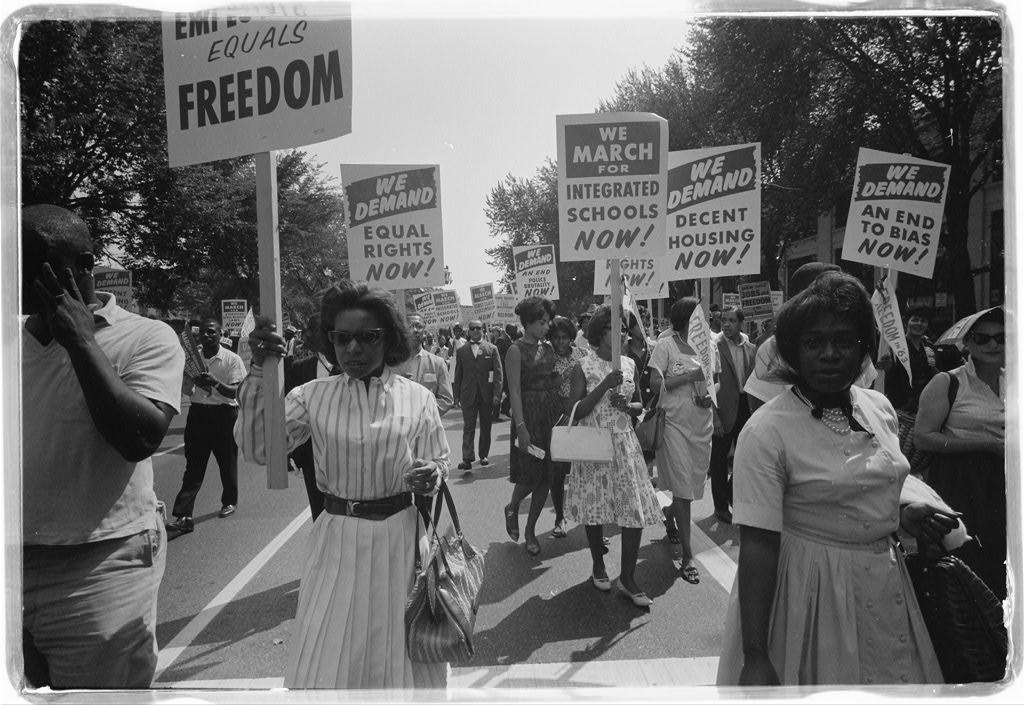Many Marches & Candid Classrooms
Last Saturday, Ellen and I presented on ASHP’s Teaching American History work at the AHA’s Annual Meeting (conveniently held in NYC this year). The session was part of a day-long “Teaching Workshop for the National History Education Clearinghouse” which the AHA has added to the conference as part of its broader outreach efforts to K-12 social studies teachers.
Our topic was “Many Movements: Teaching Black Freedom Struggles from WWII to the 1960s,” and we were joined by two high school teachers from our TAH program in Brooklyn/Staten Island, Greg Bernardi (Franklin D. Roosevelt High School) and Beth Vershleiser (Brooklyn Studio School). Ellen started off the session with an overview of our TAH program and how ASHP’s approach to teaching the civil rights movement has evolved, crediting the scholarship of Komozi Woodard, Jacquelyn Dowd Hall, and others who have convincingly argued for taking a longer and larger look at the chronology, geography, and goals of the struggle.  (Incidentally, Komozi will be talking about Hubert Harrison, an early black radical activitst in Harlem, on January 21, 2009 at 7pm at the 82nd St./Broadway Barnes & Noble. For details, go to B & N’s event listings). Then I facilitated a document encounter using two sources meant to “add to the picture” of the 1963 March on Washington for Jobs and Freedom: a photograph of women marchers carrying signs demanding decent housing, interegrated schools, jobs, and voting rights (pictured below) and a 1941 flier by A. Phillip Randolph calling for a mass March on Washington to protest racial discrimination and demand federal jobs . There was lots of agreement among participants that, for a “non-event” (the proposed march never took place), Randolph’s call to black workers was a crucial precursor to the modern civil rights movement. The photograph of women marchers largely spoke for itself as evidence of their key role as organizers and protestors on the frontlines of the struggle. Our hope is that both sources–or, more importantly, the expanded of view of the civil rights movement they help to document–will be taught in middle and high school history classrooms in dialogue with more iconic moments such as Martin Luther King’s “I Have a Dream” speech.
There was lots of agreement among participants that, for a “non-event” (the proposed march never took place), Randolph’s call to black workers was a crucial precursor to the modern civil rights movement. The photograph of women marchers largely spoke for itself as evidence of their key role as organizers and protestors on the frontlines of the struggle. Our hope is that both sources–or, more importantly, the expanded of view of the civil rights movement they help to document–will be taught in middle and high school history classrooms in dialogue with more iconic moments such as Martin Luther King’s “I Have a Dream” speech.
But do teachers agree? And why or why not? To answer this, we were really fortunate to have Greg and Beth present. Both are committed, smart public school teachers who combine their interest in history education with realistic expectations about what their students (and supervisors) can handle. They talked frankly about the challenges of teaching the civil rights movement (eg. it’s taught in May when teachers need to be prepping classes for state social studies exams) but also enthusiastically about how their experiences at the TAH Summer Institute gave them time, tools, and the motivation to develop new curricula for their students. For both, this meant totally overhauling an existing unit, the “before” version of which Beth bravely shared with the audience, that had consisted of handing out a page from a textbook, describing a very short, predictable march from 1954 to 1964 and then asking students to define some key terms as the assessment. Working with their colleague, Judy Nathan (Brooklyn Studio School), they developed a new lesson intended to teach a broader view of protest methods entitled “We Shall Overcome-But How? Strategies of the Civil Rights Movement.” Students examined photos and first-person accounts covering a range of people, places, and struggles, and then were asked to choose among several discrimination scenarios and determine what strategies they would to protest the injustice. Greg, Beth, and Judy tested the lessons during the 2007-08 and, though pleased with increased student engagement and better understandings, made several adaptions, particularly to the assessment piece (eg. students were applying presentist solutions to the scenarios). Beth admits that the lesson is still “a work-in-progress” but one that she and her colleagues feel is well worth the effort.
As audience participants Josh Brown, Daisy Martin, and David Gerwin all noted, Beth and Greg spoke with tremendous candor, sincerity, and courage about the challenges and rewards of teaching history.
Last 5 posts by Leah Yale Potter
- ASHP Wins Digital Media and Learning Competition - March 19th, 2012
- Design by Country - July 9th, 2010


